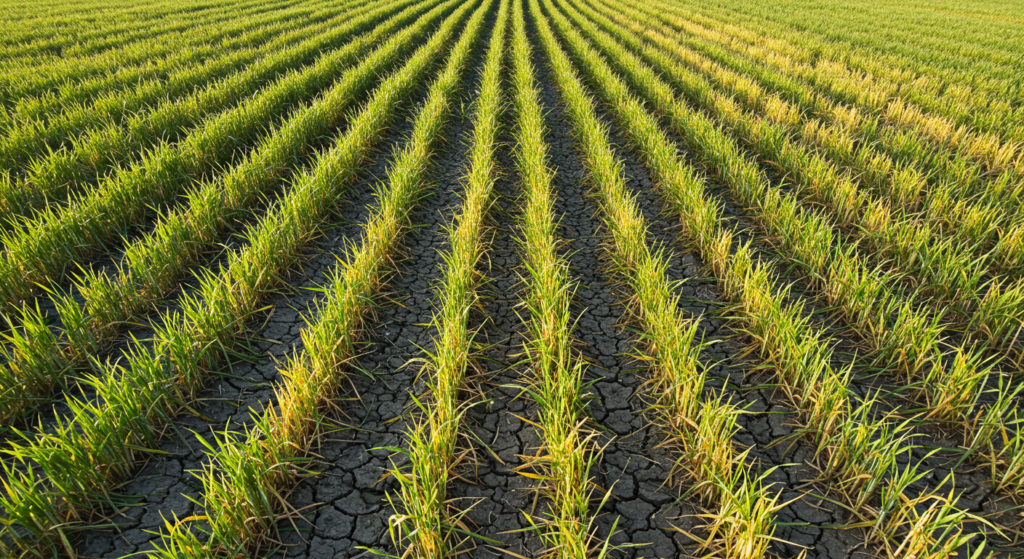
Pakistan, a country whose economy is deeply tied to agriculture, is facing a severe climate crisis. The nation is experiencing one of its worst droughts in years, with minimal rainfall and an alarming absence of snowfall in its northern regions. This climatic shift poses a major threat to Pakistan’s food security, water supply, and overall economic stability.
For a country where nearly 60% of the population depends on agriculture for their livelihood, the lack of rain is more than just an environmental concern—it is an existential crisis. The major crops that drive the economy, such as wheat, cotton, and rice, are struggling to grow in dry, arid soil, pushing farmers into financial ruin. At the same time, underground water reserves are depleting at an alarming rate, making it even harder for both urban and rural populations to access drinking water.
The Decline in Rainfall and Its Impact on Agriculture
Since September, Pakistan has seen a drastic reduction in rainfall, leaving vast agricultural lands dry and unproductive. The impact is especially severe in provinces like Punjab, Sindh, and Balochistan, where farming is the backbone of the economy.
- Punjab, which is often called Pakistan’s “food basket,” recorded a 42% reduction in rainfall. Farmers here, who heavily rely on seasonal rains for wheat cultivation, are now seeing significantly lower yields.
- Sindh, another key agricultural region, experienced a 52% rainfall deficit, causing problems for rice and cotton growers.
- Balochistan, already struggling with desertification, had a 45% drop in precipitation, making irrigation even more challenging.
Farmers in these regions report that crop yields are less than half of what they used to be. Many have resorted to deep underground wells to irrigate their fields, but with falling water tables, even this is proving unsustainable.
The Impact on Major Crops
Pakistan’s most essential crops—wheat, cotton, and rice—are particularly vulnerable to prolonged drought conditions.
1. Wheat Crisis
Wheat is the staple food of Pakistan, but this year, its production is facing a serious crisis. Farmers in Punjab and Khyber Pakhtunkhwa report that wheat plants are failing to germinate due to dry soil conditions. Even in areas where some rainfall has occurred, it has been too little, too late. The insufficient water supply is affecting the grain development, leading to poor-quality crops and reduced output.
2. Cotton Decline
Cotton, one of Pakistan’s top export commodities, is another casualty of the drought. Lack of moisture has affected cotton plant growth, and pest infestations have become more common due to weakened crops. The decline in cotton production threatens the country’s textile industry, which is a major contributor to Pakistan’s economy and exports.
3. Rice Shortages
Pakistan is one of the world’s leading exporters of rice, but this season, rice farmers are struggling to cultivate their crops. The shortage of water for irrigation is forcing many to abandon their fields or reduce their cultivation area, leading to potential declines in rice exports.
Water Crisis: A Growing Threat Beyond Agriculture
The drought is not only affecting crops but is also drying up underground water reserves, which millions of Pakistanis depend on for drinking water.
- Groundwater levels in major cities like Lahore, Karachi, and Islamabad have been dropping rapidly, forcing people to rely on expensive water tankers.
- Many villages in Balochistan and Sindh are already facing severe water shortages, where women and children have to walk long distances just to fetch a few liters of drinking water.
- With lower river flows, hydropower generation has also been affected, leading to increased electricity shortages.
If the current situation continues, Pakistan could face an unprecedented water crisis in the coming years, making it one of the most water-stressed countries in the world.
Economic Consequences of the Drought
A prolonged drought has devastating effects beyond agriculture. It can cripple Pakistan’s economy in multiple ways:
- Food Prices Will Skyrocket – Reduced agricultural output means Pakistan will have to import more wheat, rice, and vegetables, driving up food prices and increasing inflation.
- Textile Industry Will Suffer – With lower cotton production, Pakistan’s textile sector, which employs millions, could face job losses and decreased exports.
- Reduced Agricultural Exports – Pakistan earns billions from exporting rice, fruits, and cotton. A drop in production means the country will lose valuable foreign exchange earnings.
- Increased Unemployment – Farmers, agricultural laborers, and workers in related industries will face financial difficulties due to declining productivity.
A failing agricultural sector can lead to social unrest, as people struggle to afford basic necessities. The government must act swiftly to mitigate these risks before the situation worsens.
Can Pakistan Survive Without Rain? Possible Solutions
With the looming crisis, Pakistan must take immediate action to prevent a full-scale agricultural and water disaster. Here’s what can be done:
- Efficient Water Management – Pakistan needs better irrigation techniques like drip irrigation and rainwater harvesting to make the most of available water resources.
- Drought-Resistant Crops – Investing in genetically modified crops that require less water could help farmers sustain their yields.
- Groundwater Conservation – Preventing excessive groundwater extraction is crucial to ensure long-term water availability.
- Tree Plantation and Reforestation – Trees help in retaining moisture in the soil, reducing desertification and increasing rainfall chances.
- Government and International Support – The government must seek international aid and technology to tackle climate change and water scarcity effectively.